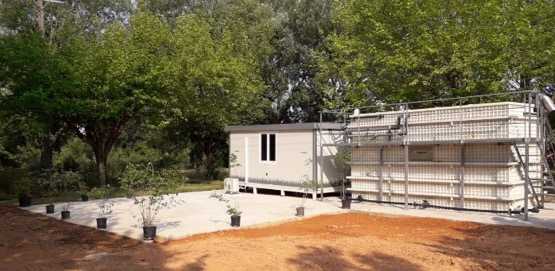
Unique selling points
- Produces irrigation water on-site where the demand exists
- Has small footprint, fits into a container, can be used in dense urban environments
- Demonstrates high replication potential
- Enhances resilience of cities to climate change especially for arid urban environments such as cities in the Med
Description of the technology
Sewer Mining is a treatment plant in a container in which:
- extracts wastewater from local sewers that run under every location of a city
- treats it directly on site in a distributed system
- produces high quality water (at the point of demand) suitable for irrigation of green areas, groundwater recharge and other urban uses.
The Sewer Mining unit consists of a membrane bioreactor unit (MBR) and a UV disinfection unit. The unit is integrated in a container of limited dimensions and the treatment is performed locally, where the demand exists.
The main idea of this technology is that a resource (wastewater) that lies beneath every part of a city is used to produce clean water and reduce pressures due to water scarcity.
The capacity of the technology is from pilot to industrial scale. In NextGen the capacity is 25m 3 /day.
Sewer Mining technology is a distributed, flexible and autonomous circular economy solution.
Flow scheme of the technology

Pictures
Synergetic effects and motivation for the implementation of the technology
- Production of reclaimed water from sewer in the point of use, minimizing the costs of distribution.
- Proven to be stable in operation and efficient in terms of treatment
- Produces high quality water rich in nutrients (N,P) with a positive effect on plants and biodiversity of the local ecosystem
- Reduces wastewater flows, transport costs and drinking water demand, protecting the natural resources
Technology requirements and operating conditions
The following table summarize the most appropriated values of several parameters to take into account during the MBR operation.
|
Parameter |
Units |
Min |
Max |
Average |
Reference |
|
COD |
mg O2/L |
330 |
490 |
410 |
|
|
BOD |
mg O2/L |
140 |
210 |
175 |
|
|
TSS |
mg/L |
150 |
220 |
183 |
|
|
TN |
mg/L |
124 |
200 |
164 |
|
|
TP |
mg/L |
9.6 |
10.9 |
10.3 |
Key performance indicators
|
Parameter |
Units |
Min |
Max |
Reference |
Legislation Limits |
|
COD in the MBR effluent |
mg O2/L |
13 |
32 |
NextGen, D1.2 |
- |
|
BOD in the MBR effluent |
mg O2/L |
1 |
2.5 |
NextGen, D1.2 |
≤10 ppm for 80% of samples |
|
TSS in the MBR effluent |
mg/L |
Detection Limit |
Detection Limit (2) |
NextGen, D1.2 |
≤2 ppm for 80% of samples |
|
Turbidity in the MBR effluent |
NTU |
0.1 |
2.0 |
NextGen, D1.2 |
|
|
N-NH4+ in the MBR effluent |
mg/L |
60 |
85 |
NextGen, D1.2 |
|
|
Total P in the MBR effluent |
ppm |
5.0 |
7.0 |
NextGen, D1.2 |
|
|
Energy consumption |
KW |
15 |
17 |
NextGen, D1.2 |
|
|
Sludge generated |
L |
700 |
1000 |
NextGen, D1.2 |
|
Links to related topics and similar reference projects
|
MBR treatment |
Medium |
Reference |
|
NextGen |
Water |
Case Study applying the technology
Publications
- Chon, K., KyongShon, H. and Cho, J., Membrane bioreactor and nanofiltration hybrid system for reclamation of municipal wastewater: Removal of nutrients, organic matter and micropollutants, 2012
- Dialynas, E. and Diamadopoulos, E., Integration of a membrane bioreactor coupled with reverse osmosis for advanced treatment of municipal wastewater
- Plevri, A., Monokrousou, K., Makropoulos, C., Lioumis, C., Tazes, N., Lytras, E., Samios, S., Katsouras, G. & Tsalas, N., Sewer Mining as a Distributed Intervention for Water-Energy-Materials in the Circular Economy Suitable for Dense Urban Environments: A Real World Demonstration in the City of Athens, 2021
- Yang, Q., Shang, H. T. and Wang, J. L., Treatment of municipal wastewater by membrane bioreactor: a pilot study, 2009



